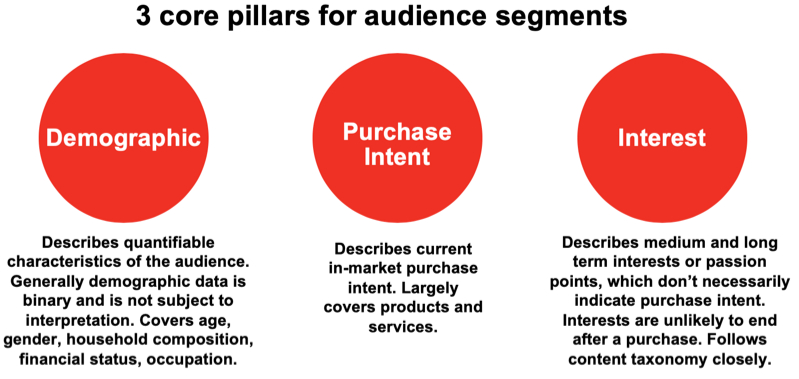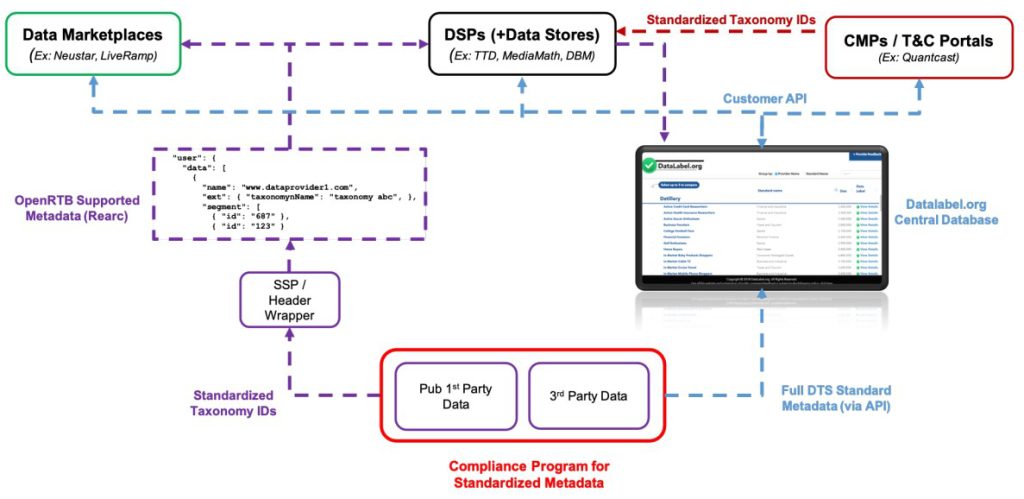Since IAB Tech Lab announced Project Rearc and released four initial sets of specs in response to the deprecation and/or limitation of third-party cookies and other identifiers, there has been a lot of collaborative work in the background – and updates from the industry regarding Unified ID Solution 2.0 and updates from Google about Privacy Sandbox proposals for both web and in-app environments.
So, in 2022 it was exciting to recently see the release of the SDA (Seller-Defined Audiences) specs as the next significant step in enabling publishers, DMPs and data providers to scale first-party data responsibly and reliably without the risk of leakage or reliance on technologies that will ultimately be limited (e.g. 3rd party cookies, IDFA & GAID).
*Note – in late 2024 Seller-Defined Audiences was rebranded as Curated Audiences
Also useful to reviews Google’s recent public support for this approach (announced on 13th Sept 2022).
We wanted to provide a simple explainer on what Curated Audiences are, how they work and what our various members should prepare for, either in-house or else collaboratively with their agency and/or ad tech partners. We hope you find it useful.
What are Curated Audiences?
There has been a lot of noise around identity solutions recently, and understandably so. However not all sellers will persistently have large numbers of logged-in users regularly authenticating themselves, as large private eco-systems (such as Facebook and TikTok) will do. Hence, IAB Tech Lab have been squarely focused on ensuring that all publishers and data providers can provide meaningful addressability against their users to advertisers across the open web without relying upon cookies or user IDs.
Publishers have unique insights into audiences due to the depth of relationship with users via the various content and services that can be consumed across all devices and environemnts. There are concerns that in the future publishers may lose the ability to easily curate meaningful contextual and audience-based signals and make them easily available to advertisers without users persistently being logged-in and the significant investment required in the capabilities needed, as the advertising landscape becomes increasingly privacy-driven.
Structured, publisher-defined audiences are an inherently-consented, easy and trustworthy way to bring these signals to life without requiring any exchange of user identifiers in the process. These privacy-by-design specifications enable both contextual signals and audience segments (across demographics, interest, and purchase intent attributes) to be safely defined, labelled, scaled and monetised by leveraging anonymous taxonomy IDs in place of cookies and mobile IDs.
Programmatic buyers can then differentiate these audiences and access those they desire within bid requests, through referencing existing data labeling and transparency standards. This will enable buyers and sellers to seamlessly transact, using valuable consumer insights, and without fear of data leakage and loss of scale, and whilst meaningfully addressing privacy considerations in the changing landscape.

What are the core benefits of SDAs?
In terms of the core benefits it’s worthwhile highlighting these for early clarity:
- Privacy safe future-proof solution – as publishers & data providers will not have to share user identifiers with external platforms and companies to activate first-party data for buyers.
- Works across all environments – from browsers and in-app to OOH and CTV.
- More efficient process – as SDA removes the need for any manual deal-ID creation processes and can be executed more efficiently similar to PMPs.
- Protects premium audiences – as publishers can share segments with buyers without revealing any first-party data IDs, minimising any risk of leakage.
- Flexibility and compliance – custom taxonomies can be supported, but only through following consistent standards and aligning to industry-led non-profit compliance processes.
How do SDAs work?
The process leverages IAB Tech Lab standards that are already in place (IAB Tech Lab’s Audience Taxonomy, Data Transparency Standard & Transparency Center) and have recently been upgraded to enable the workflows for the SDA specs. Ultimately the process will look something like:
1. Collect and curate audience segments
Publishers can determine audience attributes based on customer interactions on their properties using the IAB Tech Lab’s Audience Taxonomy. This describes and labels segmented audiences across some 1,600 demographic, interest, and purchase intent attributes.
2. Map and label targeting attributes
Leveraging the IAB Tech Lab’s Data Transparency Standard publishers can provide simple taxonomy descriptions and data transparency disclosures to buyers through 20 different fields that must be populated for each segment ID to provide more information about each segment.
As this process involves self-attestment the IAB Tech Lab have also developed an associated compliance program for this standard that allows providers to demonstrate the quality of their labeling via a Tech Lab ‘seal of approval’ issued upon program completion. This can provide buyers the assurance that the information within each ‘Data Label’ is not being misrepresented by the seller.
3. Share SDAs with Buyers in real time
Thereafter Publishers can relay the resulting anonymized taxonomy IDs within an OpenRTB bid request to inform downstream signaling by buyers – using the existing user, data, and segment objects from the ORTB 2.6 specification.
● Provider Name – the unique domain of the entity making the attribute / cohort determination
● Segment ID (s) – the provider’s declaration of the ID(s) that best describe its internal segmentation
● Taxonomy Name – the taxonomy range in which the Segment IDs / values can be found
4. DSPs review and decision against segment IDs
Buyers interested in bidding on an SDA can review the relevant segment IDs in real-time to fully understand and evaluate the cohort before bidding. The IAB Tech Lab’s Transparency Center provides a centralised location and UI to search and discover DTS metadata before making any purchase decision.
It also allows for Transparency Center subscribers to retrieve the metadata via an API and once a DSP has verified the data, it can then store the SDA mapping in their system and make the SDA segment names available for targeting by buyers within their UI. DSPs can then match incoming bid requests that contain SDA segment IDs with SDA segment names that their clients target on their campaigns.
By leveraging these already-adopted specifications in new ways, SDA establishes that publishers or their data partners 1) determine audience attributes based on customer interactions on their properties, 2) map those attributes to standardized taxonomy descriptions and data transparency disclosures, and 3) relay those anonymized taxonomy IDs within OpenRTB to inform downstream signaling by buyers. The Data flows between publisher/attribute provider, OpenRTB, and Transparency Center can be visualised as per the below:

Prebid & the ‘segtax’ extension
The IAB Tech Lab has leveraged Prebid as a turnkey solution to pass data into the bid stream. This is not a pre-requisite but using the bespoke integration with prebid.js is much easier for users of this free and open source suite. The basic workflow is as follows:
1. Publishers declare their First Party Data (FPD) using Prebid setConfig (“ortb2”) and set the attributes that are pertinent per the guidance above. Additionally, publisher’s on-page partners can set/augment “ortb2” values via Prebid RTD Module
2. SSPs will translate publisher FPD to bid requests
3. DSPs bid on the new bid requests and notify the SSP whether a bid was based on FPD data
To also enable vendor specific taxonomies a new extension has been developed called segtax, which stands for ‘Segment Taxonomies’ and can identify a specific taxonomy used to determine the provided segments.
This model supports using taxonomies other than IAB taxonomies, but all taxonomies must be registered with the IAB Tech Lab in order to be assigned a dedicated integer and all ID values of 500+ have been reserved for these vendor specific taxonomies, as per the below:

What next (and other considerations)?
For publishers, it is important to get involved in relevant forums, engage in testing and any relevant discussions and have their data in the correct format to enable these new fields to sit alongside their current data product. Advertisers should also engage with tech vendors on the required processes to enable their ad buying needs, test as soon as possible with partners and look to develop resulting innovative strategies.
Locally, we are working with IAB Tech Lab to ensure that we can support local publishers in testing SDAs and would ultimately look to run some local pilots with buyers and vendors to create a meaningful case study.
Also heartening is to see Google’s public support for this approach (announced on 13th Sept 2022). An existing Google solution already in place, which is conceptually a similar approach, is Google’s publisher-provided identifier (PPID) feature in Ad Manager 360. For current clients of this platform experimenting with this PPIDs as a starting point is potentially useful as the approach is somewhat aligned, albeit not exactly the same and not aimed at fully enabling the open internet in the same manner as SDAs.
The PPID is a string of alphanumeric figures assigned to each individual user when they visit the website. This enables publishers to attribute all their activity to a single profile, segment these users based on their interests and add PPIDs into groups are defined by common interests. These values are then passed into GAM360 to accurately distinguish users within its ad audience – even when cookies have been disabled.

Handy Links & Further Reading
Seven Key Issues Solved by the New IAB Tech Lab SDA
Seller Defined Audiences – specs
New ways for publishers to manage first-party data (Google Ad Manager)